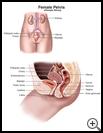
Vaginitis: Teen Version
________________________________________________________________________
KEY POINTS
- Vaginitis is swelling, burning, itching, or an infection of the vagina caused by bacteria, yeast, or trichomonas. When the vulva, the outer part of your genitals, is also affected it is called vulvovaginitis.
- Infections are treated with antibiotic pills, antifungal or antibacterial creams or gels, vaginal tablets, or vaginal inserts.
- Follow your healthcare provider's instructions and take all your medicine as prescribed. If you stop taking your medicine too soon, the infection or irritation may come back.
________________________________________________________________________
What is vaginitis?
Vaginitis is swelling, burning, itching, or an infection of the vagina. When the vulva is also affected, it is called vulvovaginitis. The vulva is the outer part of your genitals. It includes the skin around the opening of the vagina (birth canal) and urethra (where urine leaves your body). Vaginitis is a common problem among females of any age.
What is the cause?
Vaginitis can be caused by infection with bacteria, yeast, or trichomonas. An overgrowth of bacteria or yeast normally found in the vagina is the most common cause of vaginitis.
Vaginitis can also be caused by irritants such as:
- Birth control products such as condoms, diaphragms, and spermicides
- Feminine hygiene products such as perfumed sprays, powders, or douches
- Perfumed soaps, detergents, or fabric softeners
- Nonabsorbent, heat-retaining clothing such as nylon pantyhose and tights
- Antibiotic medicine
- Tampons
- Sexual devices
- Injury
- Objects in the vagina such as a lost tampon
Stress, lack of cleanliness, or a decrease in the female hormone estrogen (atrophic vaginitis) are other possible causes. Sometimes the cause of vaginitis is not known.
What are the symptoms?
The main symptom of vaginitis is a lot of whitish, gray, or yellowish discharge from the vagina. Some milky vaginal discharge is normal for females of all ages, but infections usually cause an abnormal amount of discharge.
You may also have:
- A bad odor from the vagina
- Itching or burning
- Swollen, red vulva that may be painful or itchy
- Pain during sex
- Bleeding in the vaginal area
- Symptoms of a urinary tract infection such as pain when you urinate
If you have pain in your lower belly or irregular bleeding with these symptoms, see your healthcare provider right away. If you are at risk for a sexually transmitted disease and have the above symptoms, you should also see your provider right away.
How is it diagnosed?
Your healthcare provider will ask about your symptoms and medical history and examine you. Tests may include tests of vaginal discharge, urine, and blood.
How is it treated?
Infections are treated with antibiotic medicines that you take by mouth, antifungal or antibacterial creams or gels, vaginal tablets, or vaginal inserts. Your healthcare provider may ask you to stop sexual activity for a time. Your provider may also ask that your partner be treated to prevent reinfection or spread of the infection.
Vaginitis caused by irritants can usually be treated by avoiding the irritants.
Don’t treat vaginitis with nonprescription medicine without the advice of your healthcare provider. It could be the wrong treatment.
How can I take care of myself?
Follow your healthcare provider's instructions and take all your medicine as prescribed. If you stop taking your medicine too soon, the infection or irritation may come back.
To help relieve the symptoms you can:
- Bathe with nonirritating, unscented soap. Use water that is warm but not hot. Rinse the genital area thoroughly but gently. Pat dry without rubbing.
- Wear loose-fitting, all-cotton underwear or cotton-crotch underwear. Change your underwear every day. Don’t wear underwear when you sleep at night.
- Keep your genital area dry.
- Use a vaginal lubricant if you have mild pain during sex.
Follow your healthcare provider's instructions. Ask your provider:
- How and when you will get your test results
- How long it will take to recover
- If there are activities you should avoid and when you can return to normal activities
- How to take care of yourself at home
- What symptoms or problems you should watch for and what to do if you have them
Make sure you know when you should come back for a checkup. Keep all appointments for provider visits or tests.
How can I help prevent vaginitis?
Practice good personal care habits:
- Avoid wearing pantyhose or tights for too many hours, especially in hot, humid weather.
- Clean yourself well, and wipe from front to back after using the restroom.
- Use deodorant-free white toilet paper to avoid perfume and dye that might irritate.
- Avoid using feminine hygiene products such as sprays and powders, and bath additives such as bubble baths and oils.
- Avoid douching. Your body makes a milky discharge that naturally cleanses the vagina. If you douche, you will remove this natural protection against infections and odor.
- Use deodorant-free sanitary pads or tampons.
If you tend to get yeast infections, ask your provider about using an antifungal cream when you are taking antibiotic medicine. Make sure you use back up protection such as condoms if you take antibiotic medicine while using birth control pills. Antibiotic medicine can affect how well birth control works.
Take these precautions when you have sex:
- Avoid spermicidal foams, gels, and creams.
- Use latex or polyurethane condoms the right way during foreplay and every time you have vaginal, oral, or anal sex.
- Have just 1 sexual partner who is not sexually active with anyone else and who will use protection every time you have sex.
- If you have had sex and are worried that you may have been infected, see your healthcare provider even if you don’t have any symptoms.
Last modified: 2021-08-23
Last reviewed: 2019-08-05

